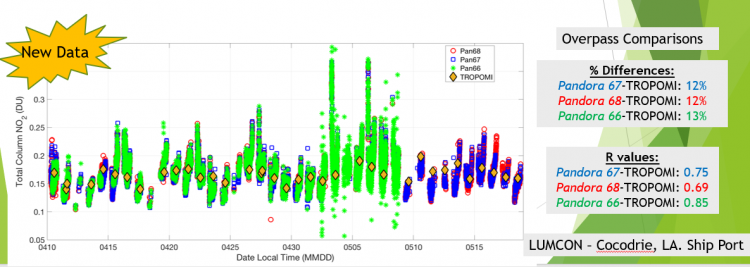BOEM is required to analyze the air quality impacts from Outer Continental Shelf (OCS) oil and gas activities to the States as mandated by the Outer Continental Shelf Lands Act (OCSLA). To support its air quality regulatory mandate, BOEM is working with the National Aeronautical and Space Administration (NASA) Atmospheric Chemistry and Dynamics Laboratory at Goddard Space Flight Center to conduct a scoping study that will assess the use of satellite data for offshore air quality assessments. Specifically, this study will determine the feasibility of using existing satellite data in offshore environments in the Gulf of Mexico region for estimating and monitoring trends of the ground level concentrations of pollutants in the National Ambient Air Quality Standards (NAAQS) (including precursors, and visibility pollutants) and to validate the satellite data with offshore monitoring in a field campaign. Preliminary results reveal two air quality "regimes" in the Gulf of Mexico region: (1) clean marine, where the wind direction is from the south, or ocean based and (2) polluted continental air, where the wind direction is from the north, or land based. A flaring event from two oil and gas platforms was successfully detected using satellite-based data from the TROPOspheric Monitoring Instrument (TROPOMI) NO2 sensor and the Visible Infrared Imaging Radiometer Suite (VIIRS) within the Hybrid Single-Particle Lagrangian Integrated Trajectory (HYSPLIT) model. At the LUMCON ship port in Cocodrie, Louisiana, TROPOMI overpass data showed a mean 13% difference from ground-based NO2 measured with Pandora sensors before and during the cruise. The excellent correlation between the ship-based Pandora NO2 data and satellite-based TROPOMI NO2 data for the offshore environment. These results indicate that TROPOMI is useful to BOEM for measuring the Gulf of Mexico and coastal pollution.
https://marinecadastre.gov/espis/#/search/study/100183

TROPOspheric Monitoring Instrument (TROPOMI) column NO2 versus three Pandora instruments reveal excellent correlation between the ship-based Pandora NO2 data and satellite-based TROPOMI NO2 data.

